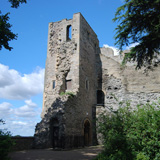History
Newark Castle resides on the east bank of the River Trent in Nottinghamshire, England. Built by Alexander the Magnificent, Bishop of Lincoln, in the 1130s as a wooden earthwork enclosure, it was rebuilt in stone near the end of the 12th century.

A Charter from King Henry I, around 1135, granted permission to the Bishop to build a castle which read:
"Henry, King of England, to all the Barons and to the Sheriffs and to his ministers and faithful men of Nottinghamshire, Greeting. Know ye, that I have granted to Alexander, Bishop of Lincoln, that he may make a ditch and rampart of his fishpond of Niwerc upon the Fosseway, and he may divert the Fosseway through the same town as he shall wish".
King John visited Newark Castle several times from 1205 onwards. And in 1206, he took control of the Bishop's Castle during a power struggle with the Pope. Ten years later, Newark Castle was entrusted to Robert de Gaughy as Civil War between John and the northern barons ensued. John would march north in 1216 to drive back the King of Scotland, who had invaded England as far south as Cambridge. On this campaign, King John would die of dysentery at Newark Castle on October 19th, 1216, traditionally from eating a "surfeit of peaches," shortly after losing much of his baggage train, including the English Crown Jewels, in the Wash.
His Son, Henry III, succeeded John and encountered resistance from one of his father's mercenaries, Robert de Gaughy, the same man entrusted to protect the castle by John. When de Gaughy refused to surrender Newark Castle back to the throne, the nine-year-old Henry III unsuccessfully besieged the castle. Henry ultimately paid de Gaughy 100 pounds in silver to abandon his position in the castle and as compensation for the supplies he left behind.
Edward II visited Newark Castle in 1323, seeking refuge from barons threatening his rule. The castle was under the guardianship of Donald, Earl of Marr, nephew to Robert the Bruce, who made improvements to the castle, including adding towers along the west wall facing the River Trent that remain today.
Newark Castle was partially destroyed during the English Civil War in 1646 on orders from Parliament after the castle surrendered to Parliamentarian forces following a long siege. Royalists occupied the stronghold on the side of King Charles I, but Charles ordered the castle to submit to the blockade in May 1646 after holding out for seven months. Townsfolk from Newark used stonework from the castle to help rebuild what was damaged in town during the previous several years.
In the mid-19th century, architect Anthony Salvin took on restoring the castle, and by 1889 it had been turned over to the Corporation of Newark, who opened a new landscaped garden in the old castle courtyard to celebrate Queen Victoria's Golden Jubilee. The castle has been open to the public to enjoy ever since.
Castle Highlights
The view of Newark Castle from the River Trent is still impressive and is one of the longest in England, yet less than twenty percent of the castle remains. The most notable feature of the castle today is the gatehouse, one of the finest examples of a 12th century gatehouse to survive in England. A bridge over a moat preceded the gatehouse, but it was unlikely to be a drawbridge as no evidence of bridge lifting gear can be found.
The North-West and South-West Towers facing the river also remain ruined, and the castle walls along the river adjoin the towers. The west walls comprised the Halls Range, consisting of the Bishop's Hall, several bedroom chambers, service rooms, and the Great Hall.
The castle contains five dungeons and prisons and, at some point in its history, held Templar Knights, whose graffiti is still evident on the castle walls. A chapel and kitchen would have been freestanding buildings in the castle courtyard.
Newark Castle can be explored in an hour or two. Other castles within reach to explore the same day are Belvoir Castle to the south or Nottingham Castle to the west.
Newark Castle is also haunted.


